Della and I are just back from a four day backpacking exploration of one of our greatest alpine wildernesses, the Mt Darling Snowy Bluff Wilderness created in 1983. This is a trackless mountain vastness suitable only for the most experienced outdoor adventurers. We return ‘bowed but unbroken’
Forbidden Wilderness: (Well they might as well be) or Backpack Hunter’s Paradises – you take your pick! Such is the nature of some of our 1980’s created ‘wilderness areas’ in Victoria where government closed the tracks and practically all activity back around 1983.
There are other areas which have been closed for even longer such as the Upper Yarra catchment – since 1939, where access is even more forbidding – and forbidden (see for example Upper Yarra Track Shelter House). The outstanding feature of the Yarra Catchment which will repay a (forbidden) visit to eg the famous Yarra Falls is that it hasn’t burned either, so you can see what bush may look like absent the influence of man for nearly a century now.
My own view is that the (light – do I have to add ‘kind’?) touch of man adds something, and that the ‘Leave No Trace‘ philosophy is overly restrictive. Also, I do not believe that my generation should just set aside areas for ‘future generations’ without being able to enjoy them ourselves – nor should our small dogs be likewise deprived. They pay their taxes too. I am not so altruistic as that!
Here are two of them anyway tasting that forbidden fruit – and finding it good! Spot: 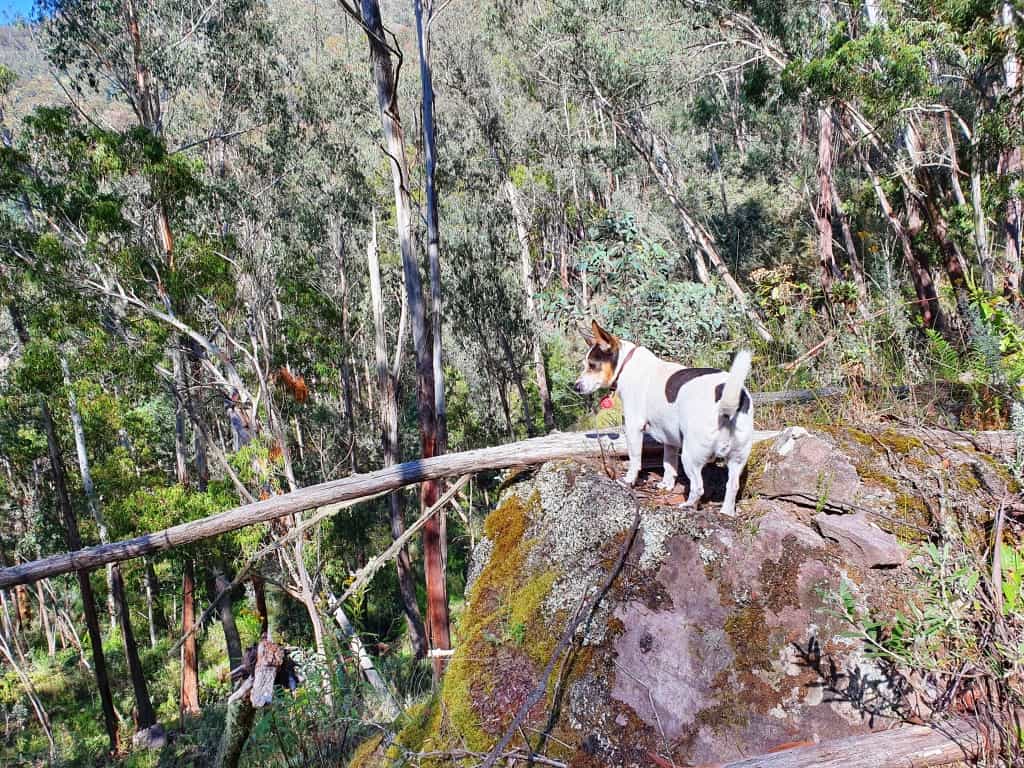
And Honey. Terrible dogs aren’t they?
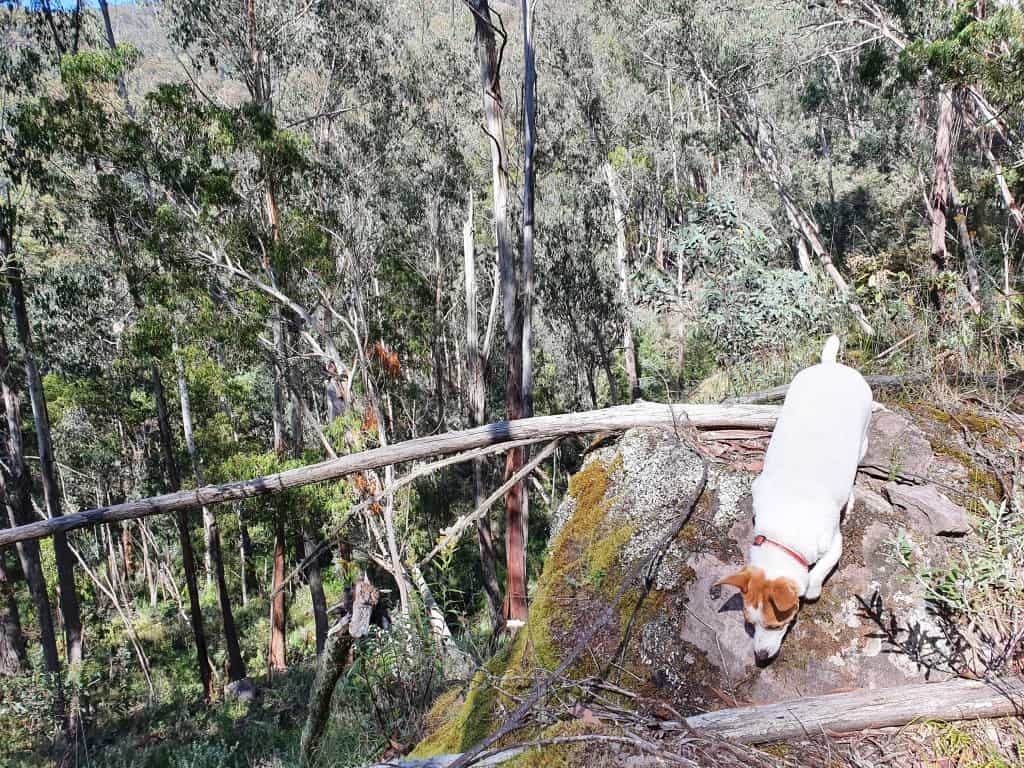
There are those who consider ‘bending’ such rules to be as heinous as burglary or car theft but such folks frequently themselves indulge eg in illicit drugs (or worse vices) whilst condemning my own innocent canine forays, defending their own behaviour by saying ‘Well, they ought to be legal’. Exactly.
Spot and Honey do so enjoy the trips, would pine without us, and do no harm whatsoever to the ‘wilderness’ areas (unlike the innumerable foxes and cats which ‘management’ allows to plague them having closed even the ‘Management Vehicles Only’ tracks so they don’t have to do any. I rest my case.
So many beautiful creatures in the wilderness. Look at this wonderful golden cockroach in the mist.
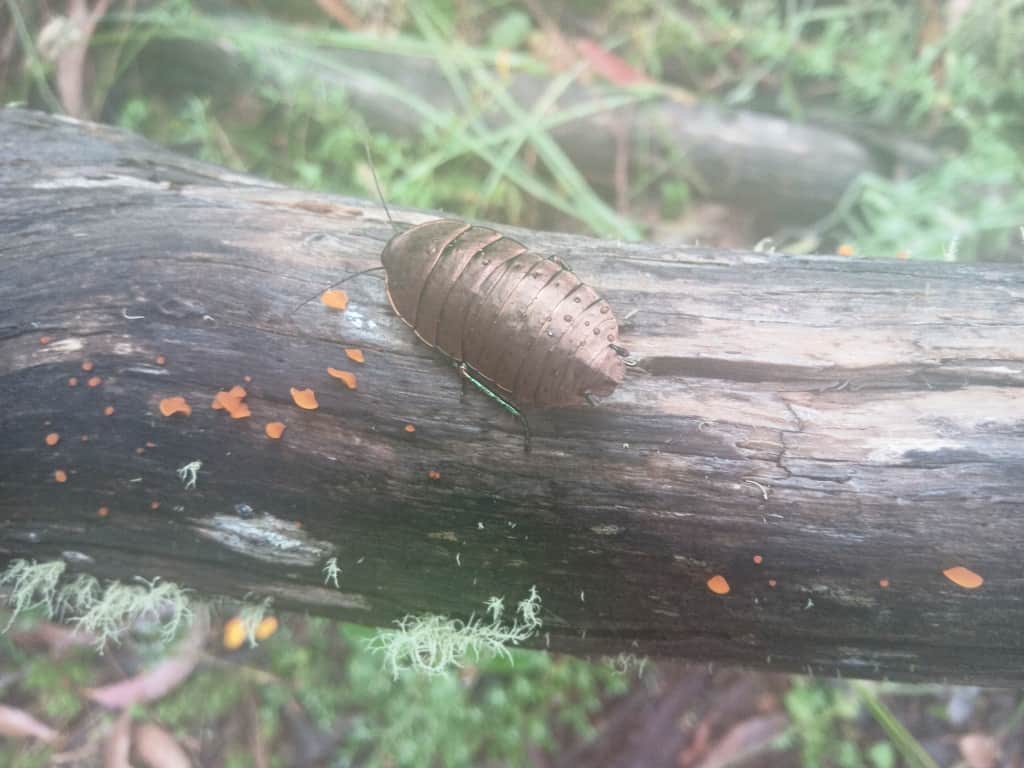
I made a foray in towards Mt Darling from Dimmicks Lookout back in 2014. See the post Snowy Bluff- Mt Darling Wilderness. I reached a point around Mount Billabong before I turned back due to lack of water. Fire burned the tops from Mt Darling to the tussocky plain (in the cover photo of that post) but not down along the Mount Creek back at the beginning of last year (2019), so that section may be considerably clearer right now than I experienced it then. I was hoping so anyway as it was well-nigh impassable then.
I had noticed a suspicious green spot (or two) right at the top of one of the highest feeder gullies of the Mt Darling Creek just north along the ridge from Billabong Mountain. If you look closely on Google Earth you will see what I mean. Sometimes there are peaty sphagnum soaks and springs high up quite close to the ridge line in alpine areas (as at Mt St Phillack Saddle on the Baw Baw Plateau for example). If there is enough water there (which may require minor ‘development’), then a pleasant sheltered camp with water could be made in the adjacent saddle. I hoped so anyway. Otherwise, see How to Create Water for Your Camp Site.
Wonderful volcanic monoliths along the Carey Road:
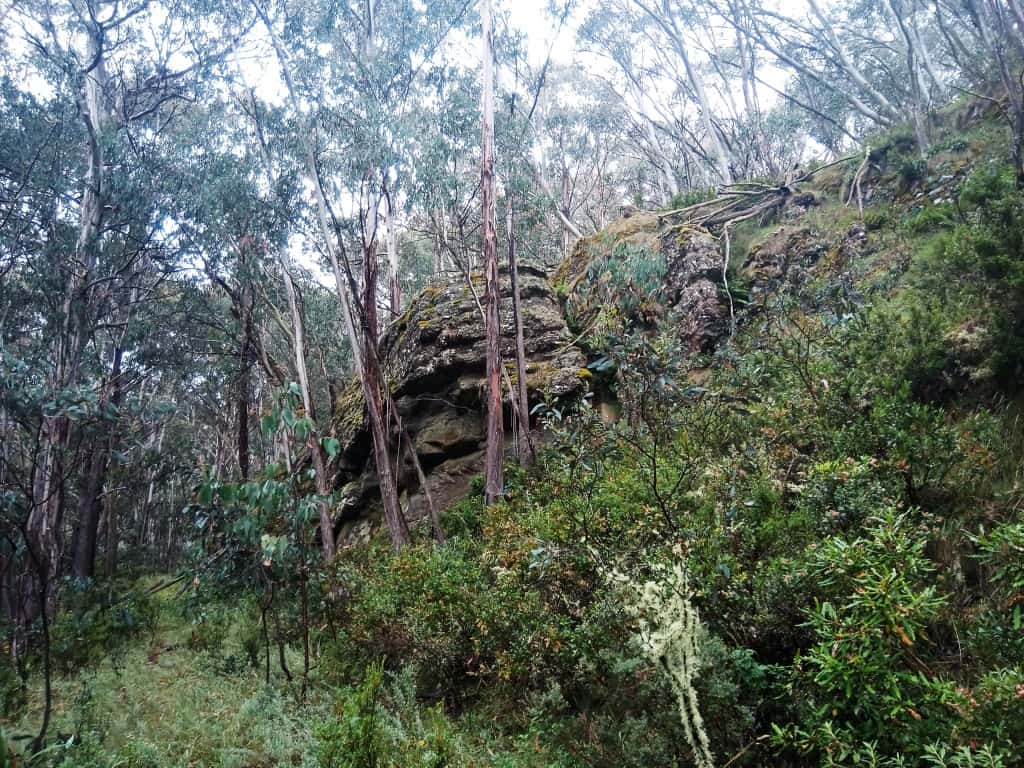
This (Billabong) spot then would make a brilliant hunting camp (to prowl the grassy plains around about) or a staging camp for those wanting to traverse to Mt Darling and then maybe on over the Mt Darling Gap whence back along the (southwards running) ridge to where Mt Darling Creek joins the Wonnangatta River where I have often camped (eg High Flying). I also considered that one could walk up the southern or middle ridge at the bottom of Mt Darling Creek and return to a camp on the Mount Creek – if stag activity had kept the ridges relatively clear – as is usually the case.
Such ‘game trails’ can be helped out with a bit of judicious thinning to make excellent backpacking routes. I believe they should be. I’m still not sure whether the ‘tree in the quad’ is really still there if no-one at all sees it (as Bishop Berkeley speculated), though the believers in ‘leave no trace’ clearly do! Anyway I am all for being able to see it from time to time, and a thin ‘line’ along which a roo, deer or hiker may pass without much trouble clearly does little ‘ecological’ harm – and walking along it certainly uplifts the blighted soul enormously.
The bush was alive with beautiful wildflowers most of which I forgot to photograph.
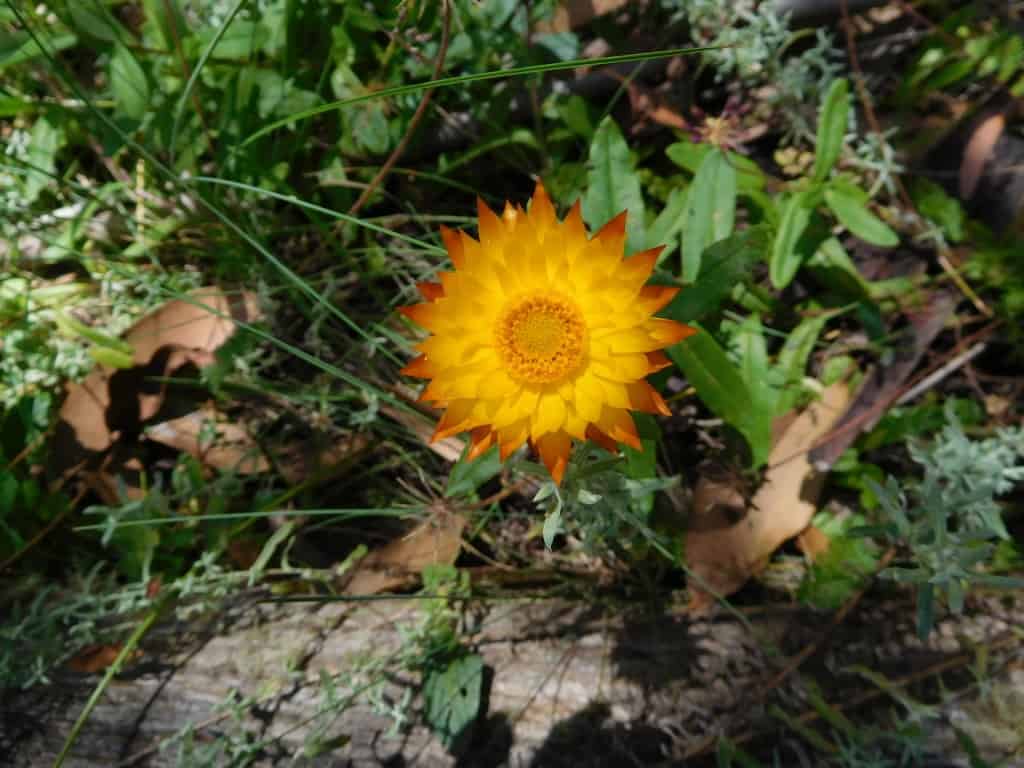
I know that there was an old hunter’s hut along the Mount Creek probably a relic from before the zone was created in 1983 (which still existed in 2009 as someone ‘discovered’ it then). I suspect it is/was (just) upstream (on the east bank) of the point where the track to the south which diverges from the Carey Road on the ridge before Mount Creek crosses the Mount Creek. This (ridge) area though is monstrously overgrown. You can scarcely force your way through it.
If I could find it I would have an excellent hunting camp. It may even be possible to restore it (or anyway reuse the materials) as a snow shelter which would be a very desirable facility. Corrugated iron lasts a long while in the bush. I could perhaps leave a slightly heavier version of one of my tent stoves in there to (economically) warm it. ‘Life is what happens while you are busy making plans’ as John Lennon used to say.
It could happen to me here any day:
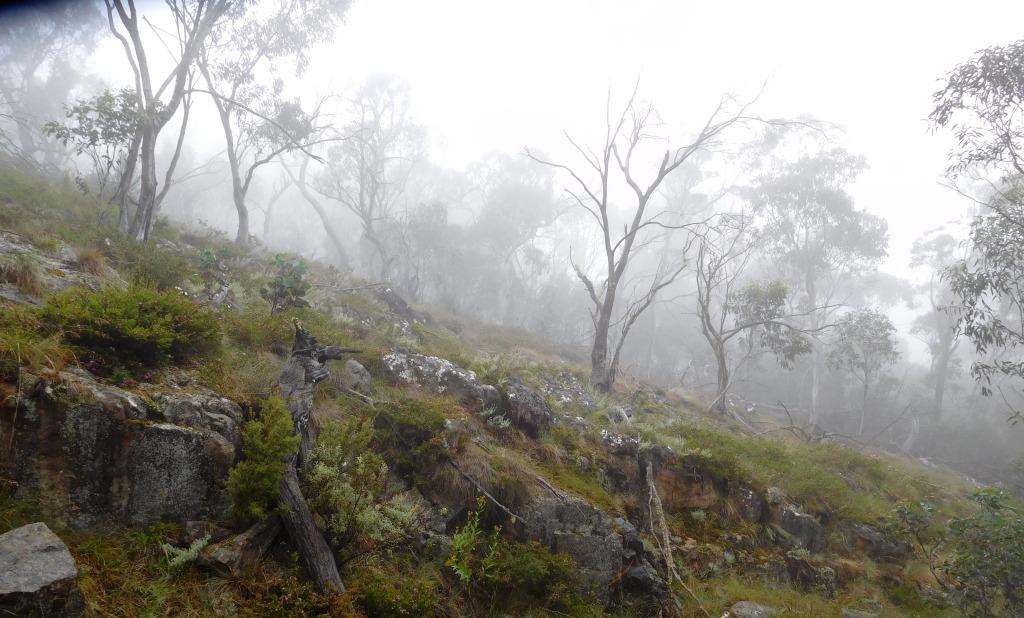
I hoped to find it and/or congenial camping sites anyway (along the Mount Creek) giving good close (easy) access to the thousands of acres of flat tops just above it to the east, and to the numerous swampy clearings along the Mount Creek (which are incidentally) full of sambar wallows! (NB: You can easily see these clearings on Google Earth).
Mount Creek is a nearly permanent water source starting right on that Snowy plain. (In summer-autumn go after rain to be certain). Down towards the hut where it spreads out into innumerable tussocky, sphagnum bogs etc It is a crystal clear stream (with a sandy bed) between 1-2 metres across, the sort of place where you would expect to see trout fingerlings if they could get up that high. I saw none so perhaps they can’t, but I have not studied it long or hard.
You can still see that Carey Road and the Mt Darling Road on the Victorian Game Management Unit’s Guide to deer Hunting Mapsheet no 51 (See here) and it is on the old Mt Darling Vicmap but not on the new Moroka North mapsheet. (leaving off all these ‘closed’ tracks and roads is a mistake I believe as they can be an invaluable tool for route finding).
Two views down into the Carey Creek
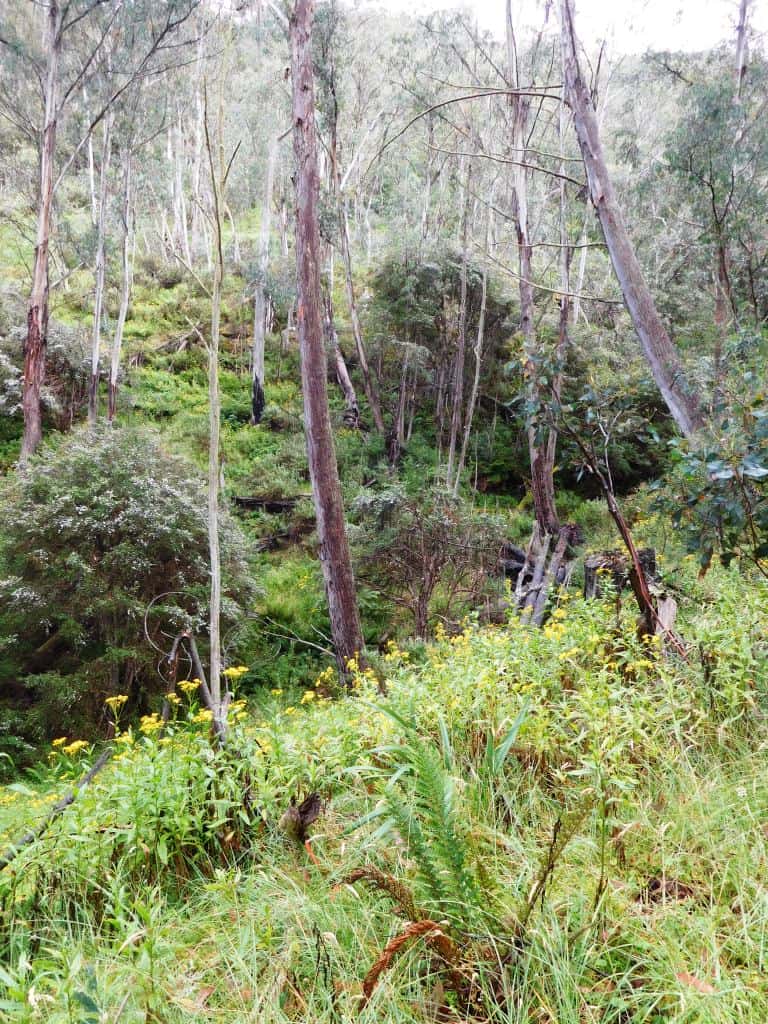
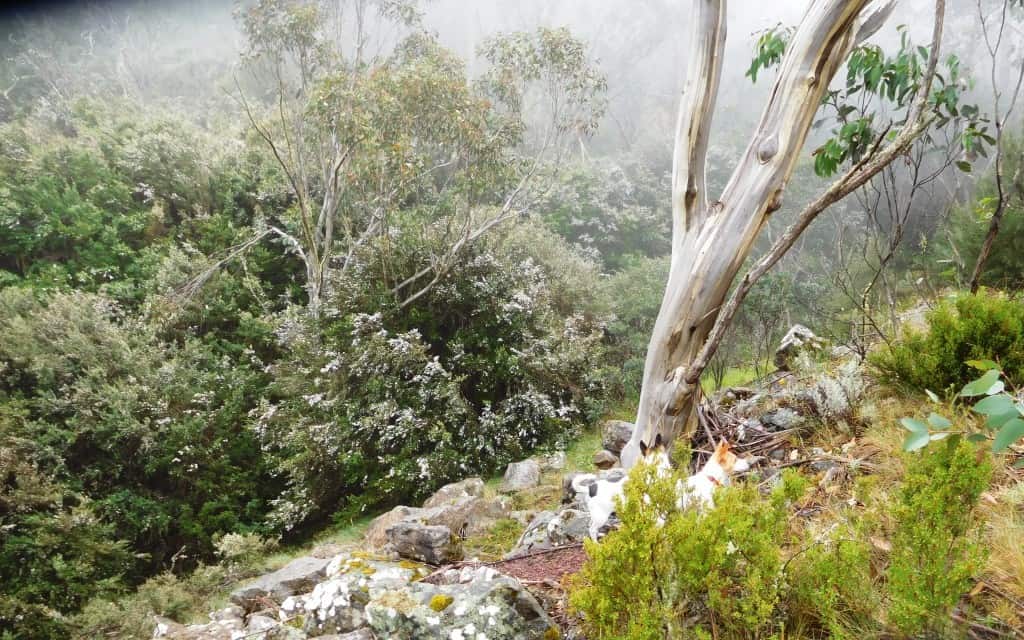
On Mapsheet 51 you will see where the Carey Road crosses the Mount Creek. Just before that there is a loop where the ‘road’ turns from the south to the north on a ridge. There used to be a road junction there. Another track fell away south-east and crossed the Mount Creek about a kilometre downstream. It is in the vicinity of that crossing (probably just above it on the east bank) that I believe the hut is/was. This area along the Mount Creek has not burned since 2009.
Frankly much of the area is so thick it could use a good fire through it. If it were my property I would never neglect it as Parks Vic do/has. I have owned many properties which included large areas of native bush. Similarly most of the (so-called) Alpine National Park would immensely benefit from Mountain Cattle grazing it – but that is another story.
Fire and ice tear the very earth apart as it has cloven this stone. Finally all the mountains will be ground down to a flat dusty plain. We must do something. Stop the world I want to get off! Soon enough perhaps?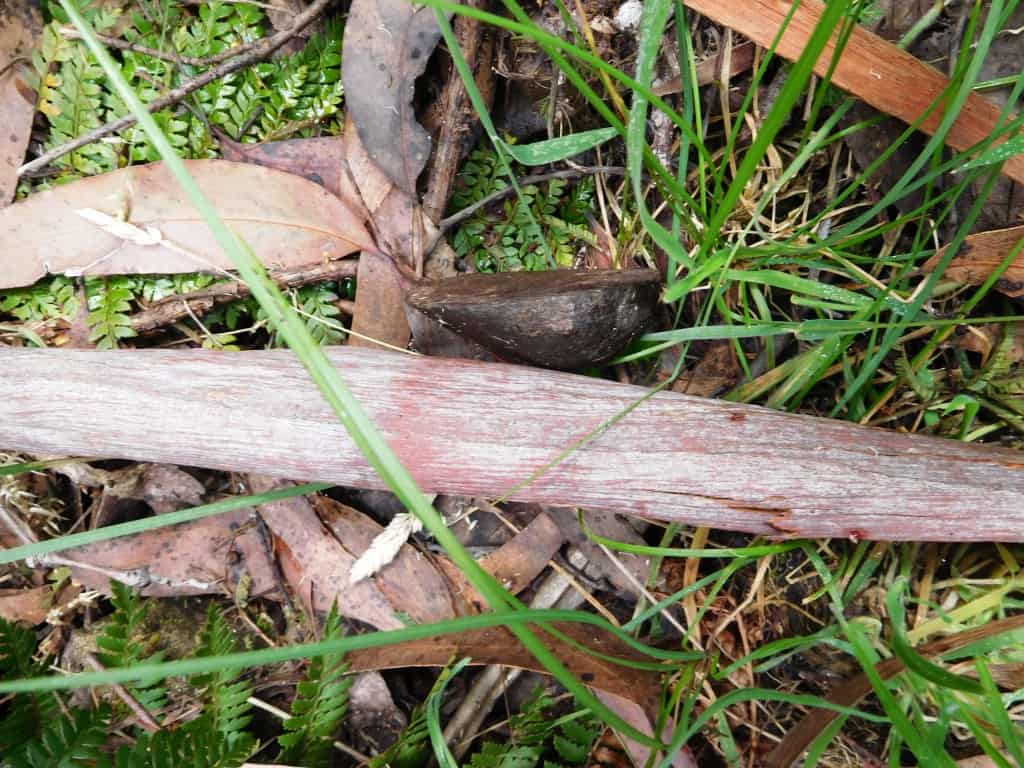
I am not a believer in National/State Parks at all, as you may know! I think most of these areas would be better off managed as multiple use State Forests (including logging, mining, grazing etc) or as private property. This would support a richer proliferation of both flora and fauna as well as many more human opportunities. Probably such a time will come again though I will not see it.
There is much do-gooder nonsense needs undoing before we are done, or we will leave a world unfit for man or beast. To me you should understand ‘conservation’ is a dirty word, as I see again and again the huge destruction of the natural world its proponents have wrought.
Hunting the tussocky clearings between those two crossings and also below the lower crossings should be superlative – as would the plateau above generally to the East. There were antlers lying around all over the place in the wallows but they were too far in for me to want to carry them out. I have long since given up on Della’s idea of an antler archway, but I still collect them sometimes (eg Mitchell River Day 3) perhaps to make towel racks or other bric-a-brac out of.
I assumed that the ‘going’ at least as far as the snowy plain would be similar to what it was in 2014. I had ‘helped’ to clear it then and I assumed that lots of others would have traversed it since. At the Carey Road crossing of the Mount Creek there was a huge cache of hunter’s supplies in 2014 – probably ten lidded boxes full of all sorts of ‘goodies’ so I figured at least they and others would have been regularly coming and going – especially since hundreds of people had read my 2014 post since then. They are probably still there.
I expected the track to be in this condition all the way. This is one of the better sections we encountered.
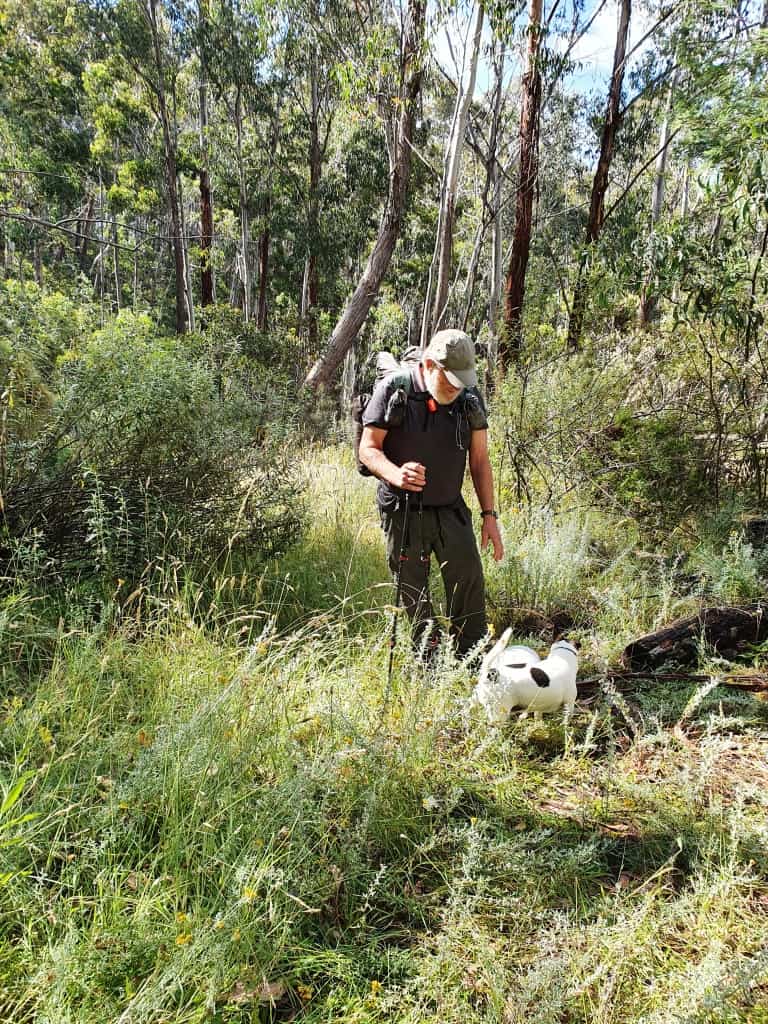
It only needs one or two people a year to walk along a track with a machete to keep a walking path clear enough to use hiking poles. It should only be about 2-3 hours on from Dimmicks to the snowy plain above Mount Creek and another hour to the ‘camp’ above Billabong then perhaps another to Mt Darling, if the going were good! Since last year’s fire had cleared above the snowy plain I thought the walk would be a ‘doddle’ – my description to Della, poor thing!
As it happened practically no-one had been traveling the ‘track’. This should have been apparent right at the start where we had to push our way through about fifty yards of prickly hakea (which sadly for you I still have not cleared! However, after that it opened up. I did not have recourse to a machete until I was half way down the switchbacks. The going was reasonable then along the level section to where the last water is.
A pause on the switchbacks:
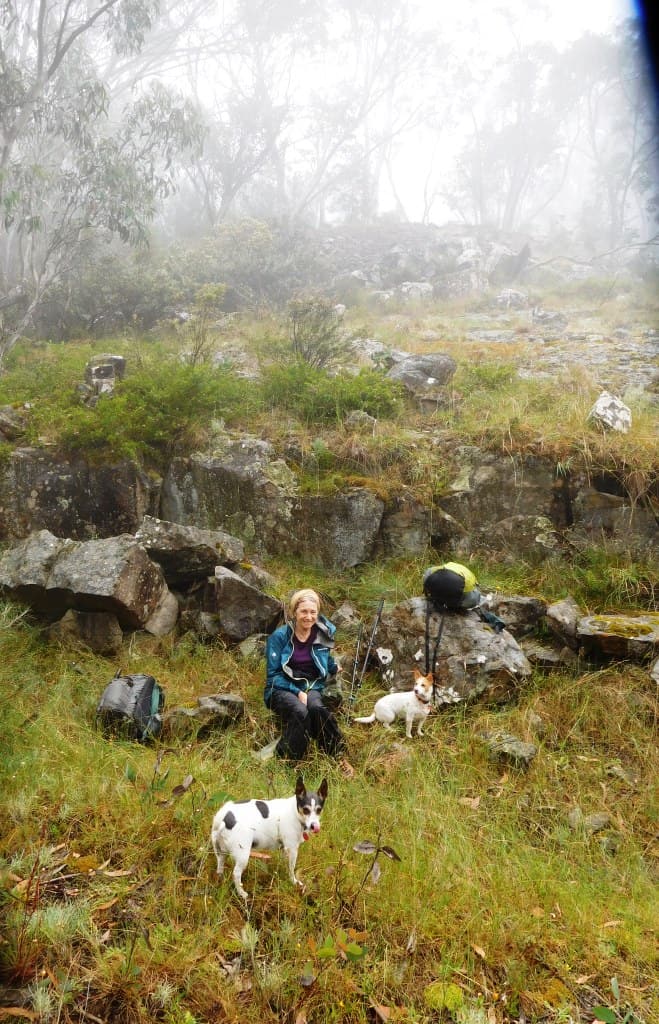
Pay attention to this! Once you leave the Carey Creek when the switchbacks end there is only one source of water before the Mount Creek. There are three wet patches just after the (beautiful) plum tree. It so lifts my heart to see such beautiful introduced trees in such unlikely places. They have zero chance of ever ‘taking over’ (however intensely desirable I may feel that to be!) so they should be left to ‘improve’ the native landscape. They are as much a part of this continent’s history as any other piece of flora (or fauna).
Surely it enhances the landscape, and makes a significant way point?
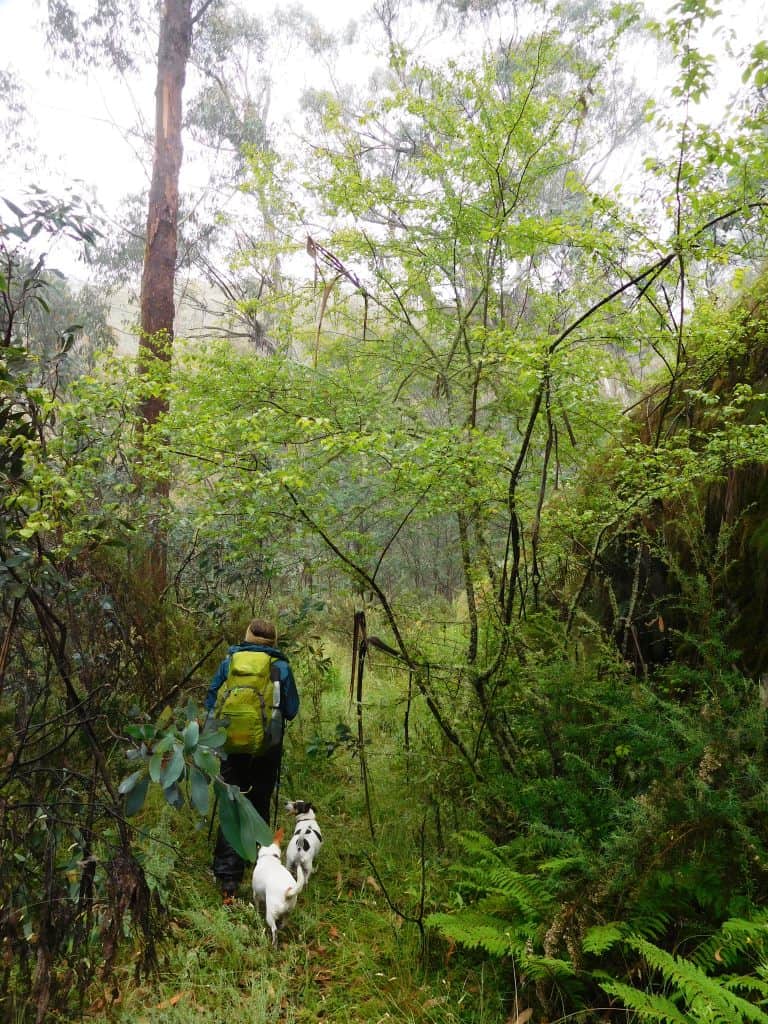
The best water is a culvert on the left coming down from some huge volcanic monoliths above in a narrow gully. You should hear the water trickling musically through the under-road pipe. You may have to part some ferns to get at it but it falls just enough to fill your water bottle up perfectly, and is crystal clear and delightfully cool, though there are many small leeches. And here it is:
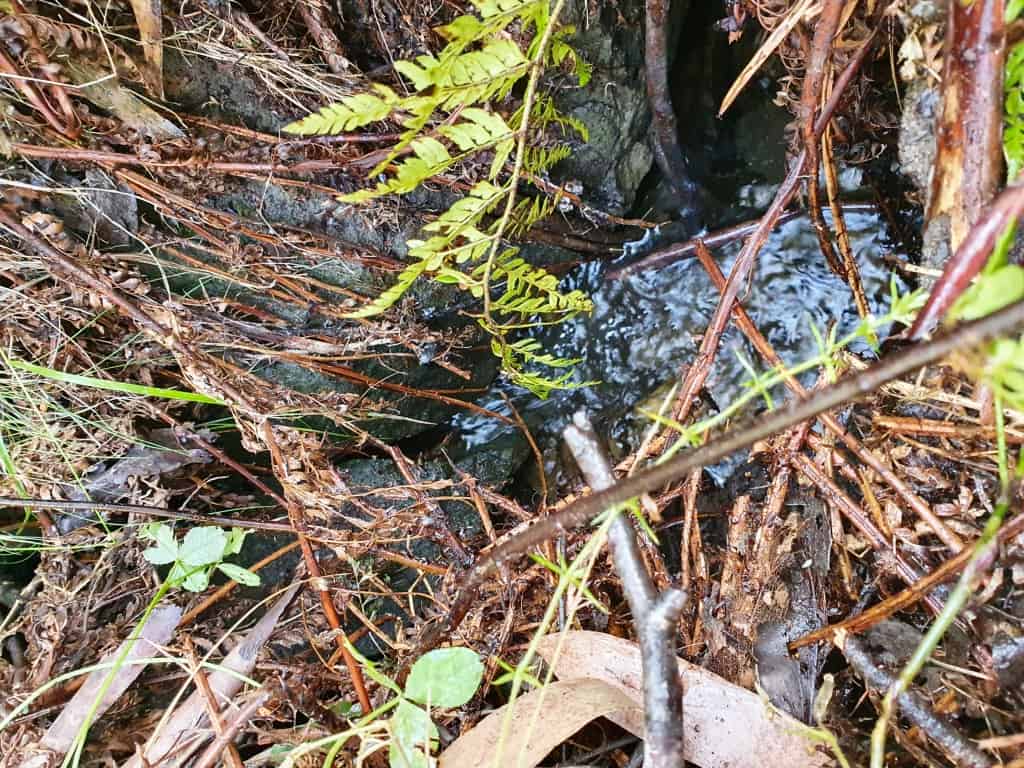
Falling down from those monoliths above.
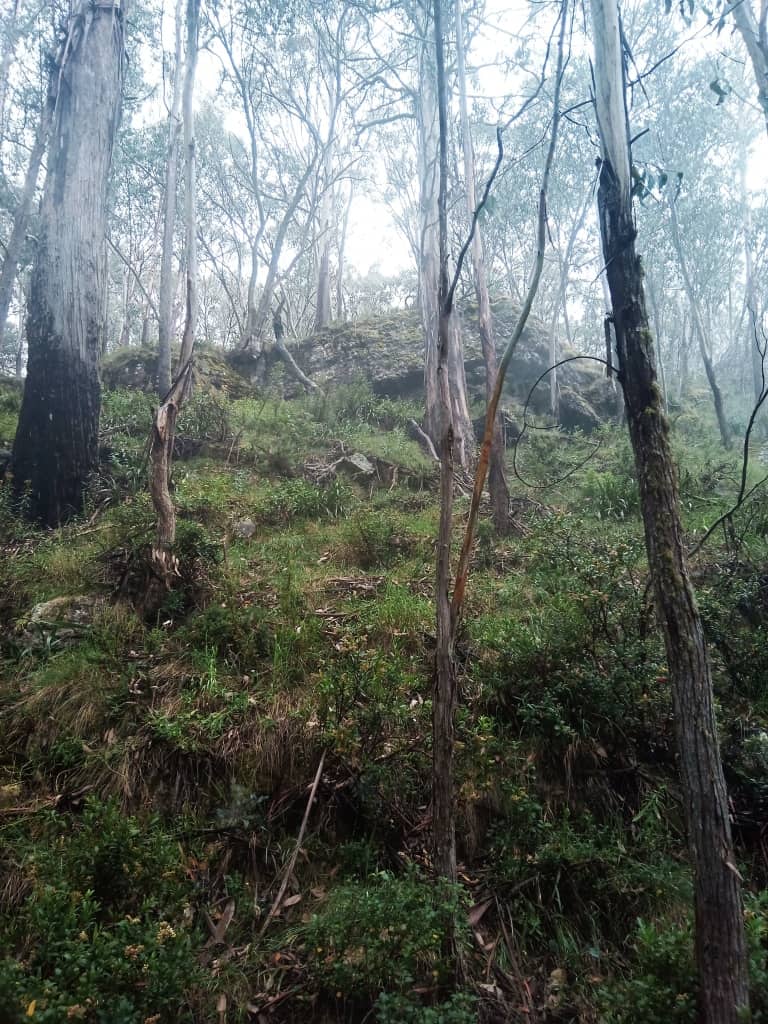
You can camp at this spot though it slopes a bit more than I would like and the road surface is hard for tent pegs. However we did twice (coming and going). Fill up with water here. If you intend to camp at the Mt Darling Saddle (about 1 1/2 hours ahead) carry your water from here. This saddle would be an ideal place to construct a water catchment device such as I described in the post How to Create Water for Your camp Site. If you intend to carry on to Mount Creek carry enough water to get there. The going after My Darling Saddle is at present simply awful, so this will take you much, much longer than you think is possible.
The advantages of camping in just such a spot when you wake up in the clouds are obvious I think.
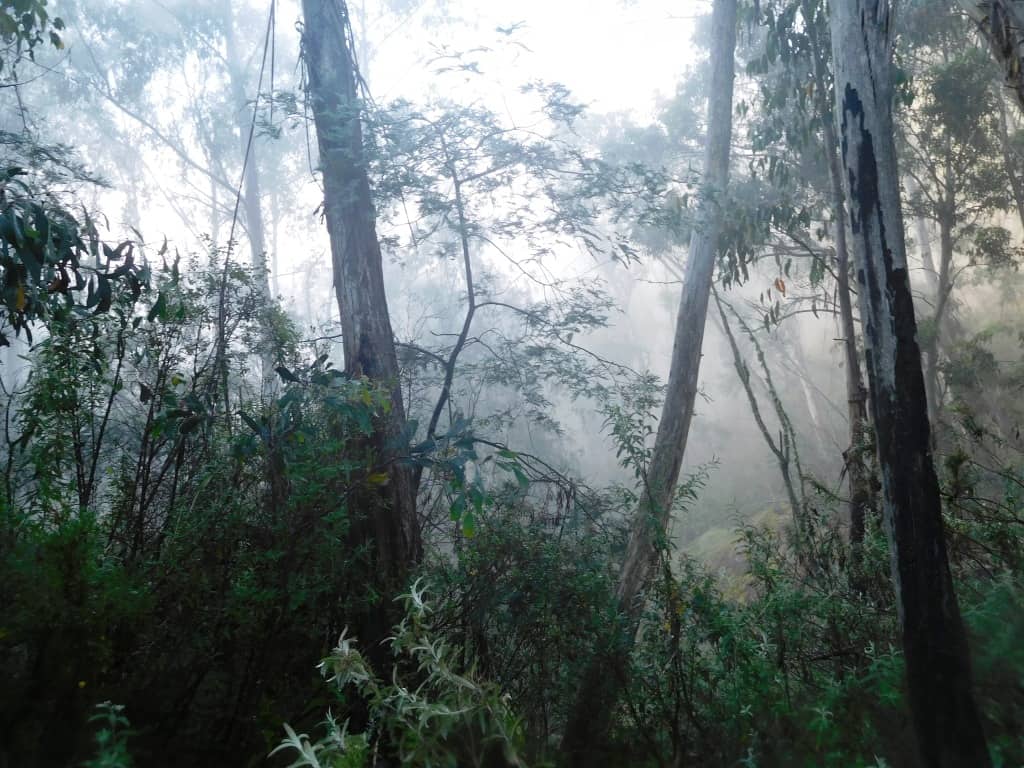
The morning sunlight is just magical. This experience is worth more than mere money.
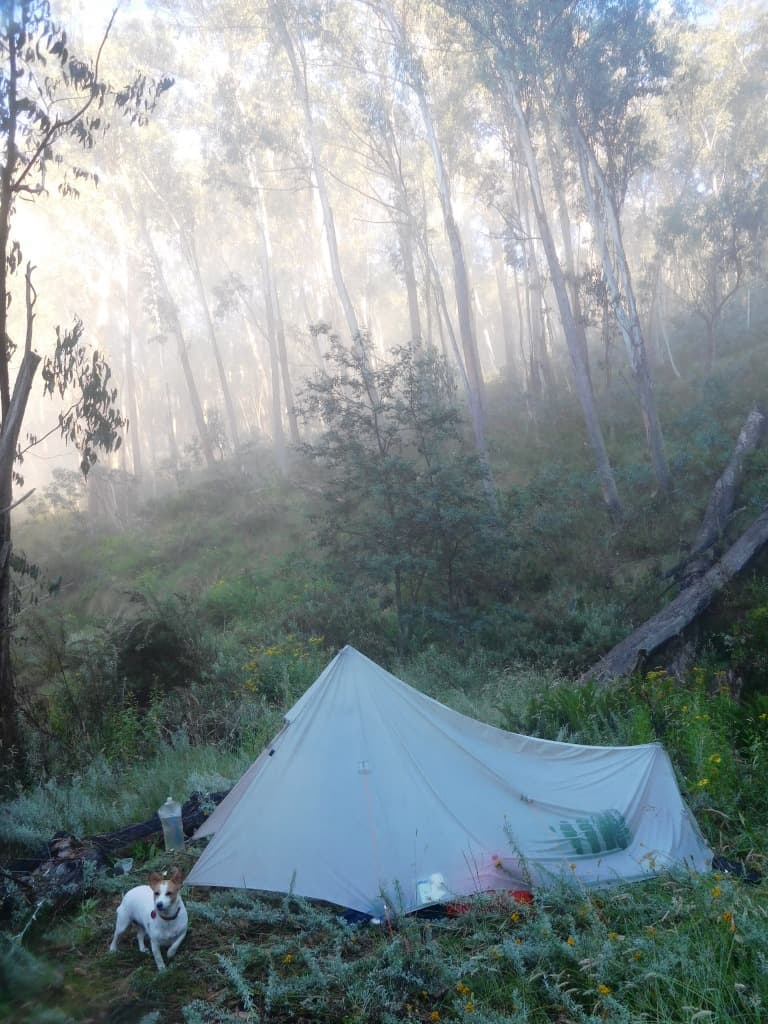
Morning has broken. Genesis.
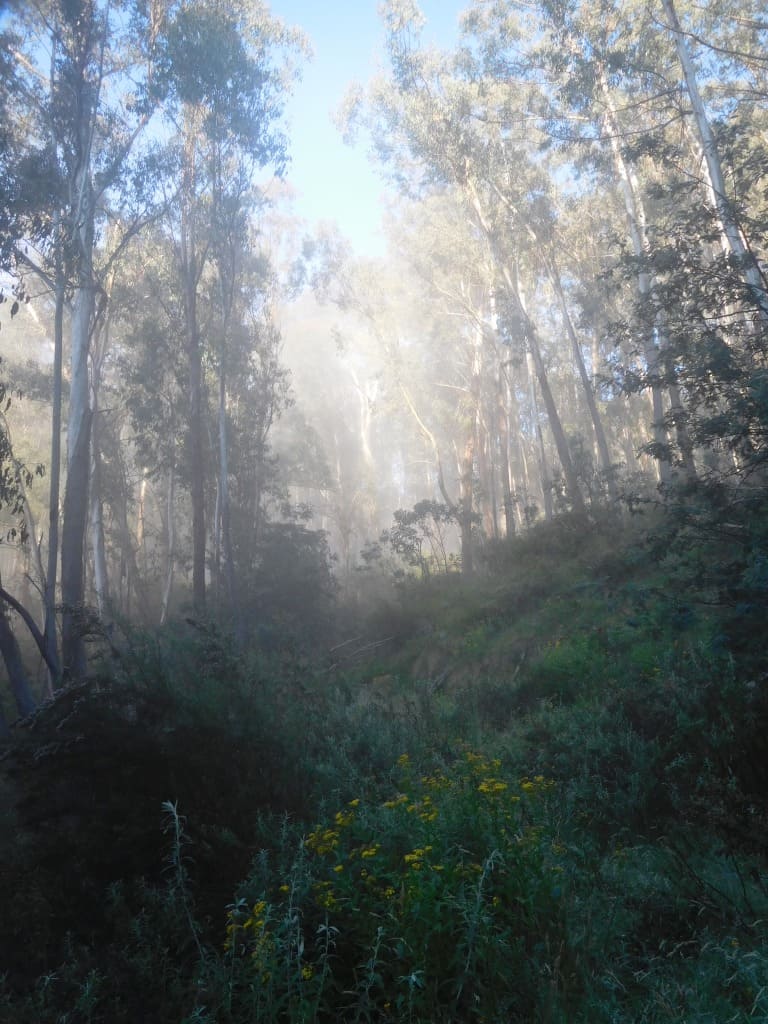
Lo, how the mighty are fallen.
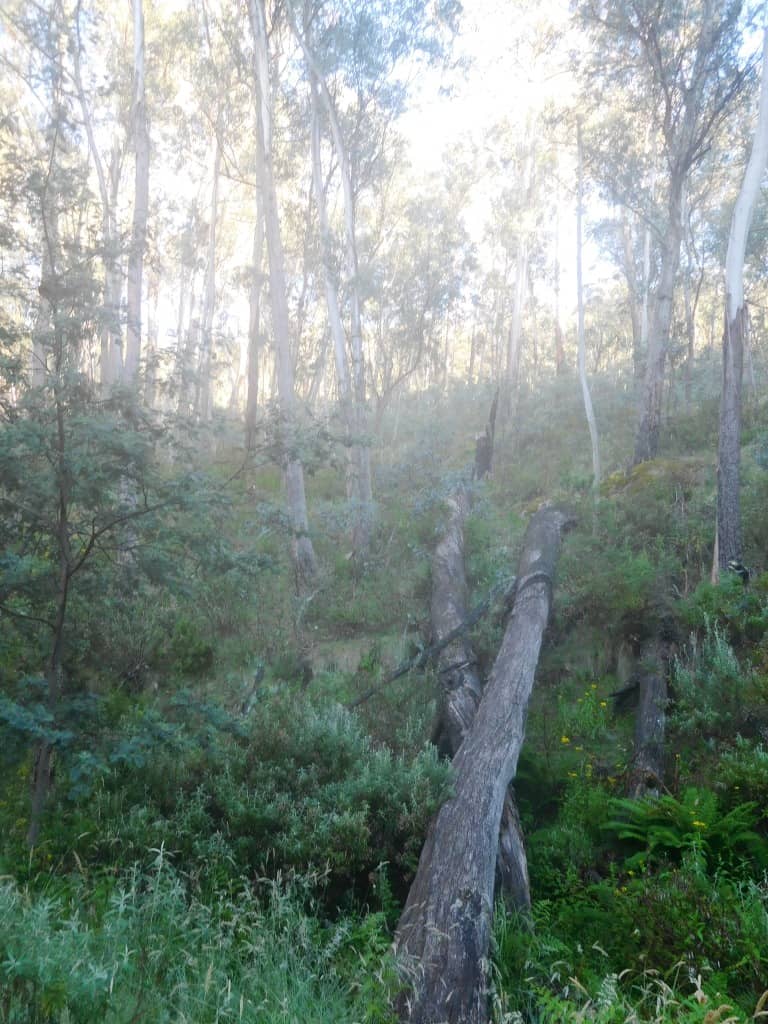
The dawning of a new day.
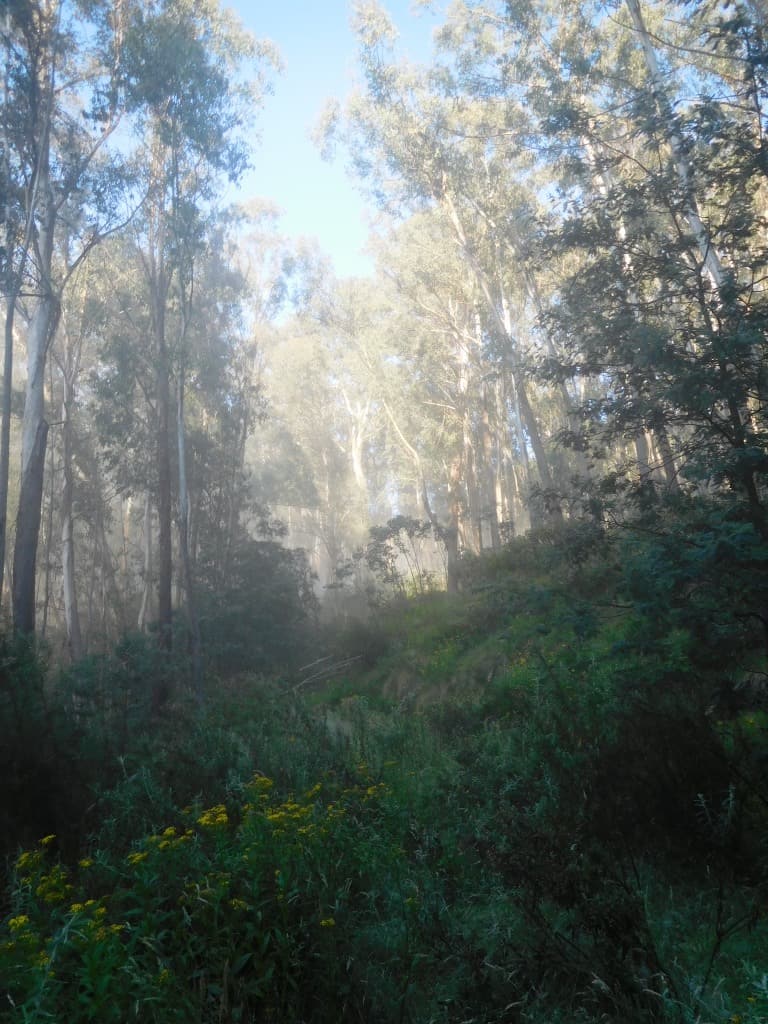
Is there anything better than a camp in the mist?
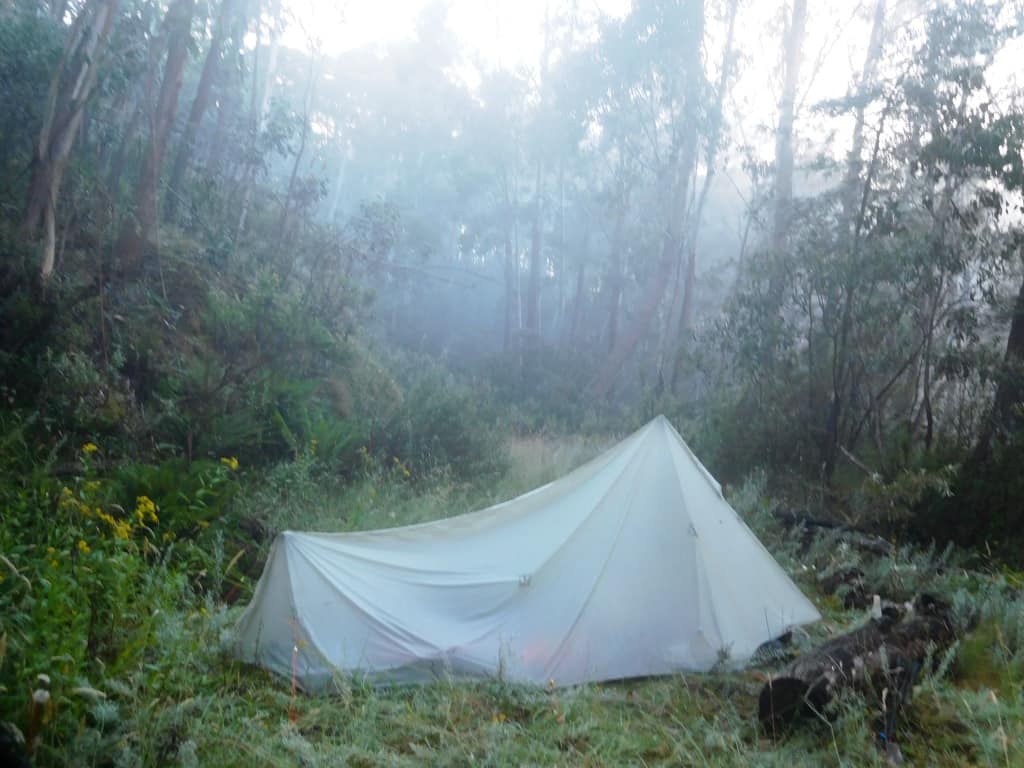
There are (sort of) two Mt Darling saddles. The first one is a switchback. You will think the track has just cut out, but look behind you and you will see it disappearing down the slope to your right. It switchbacks again then traverses slowly down to the beautiful saddle which must once have been a horse paddock. There is still a pleasant grassy area right at the top – and on this occasion a comfy log to sit on and enjoy lunch. Like this:
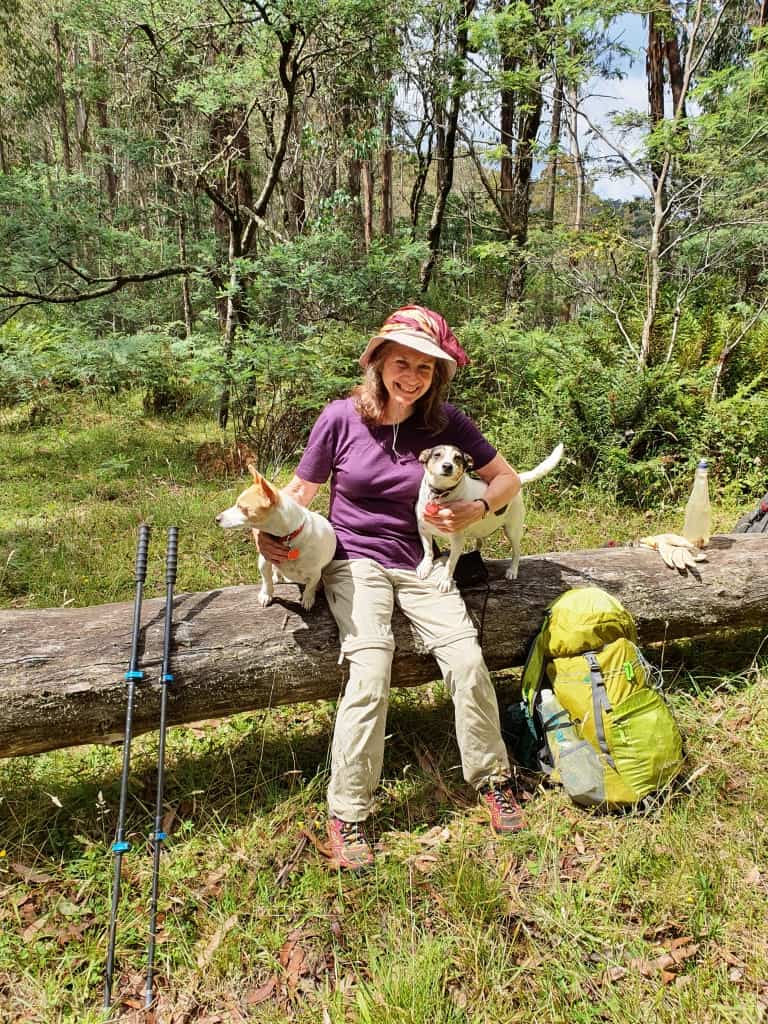
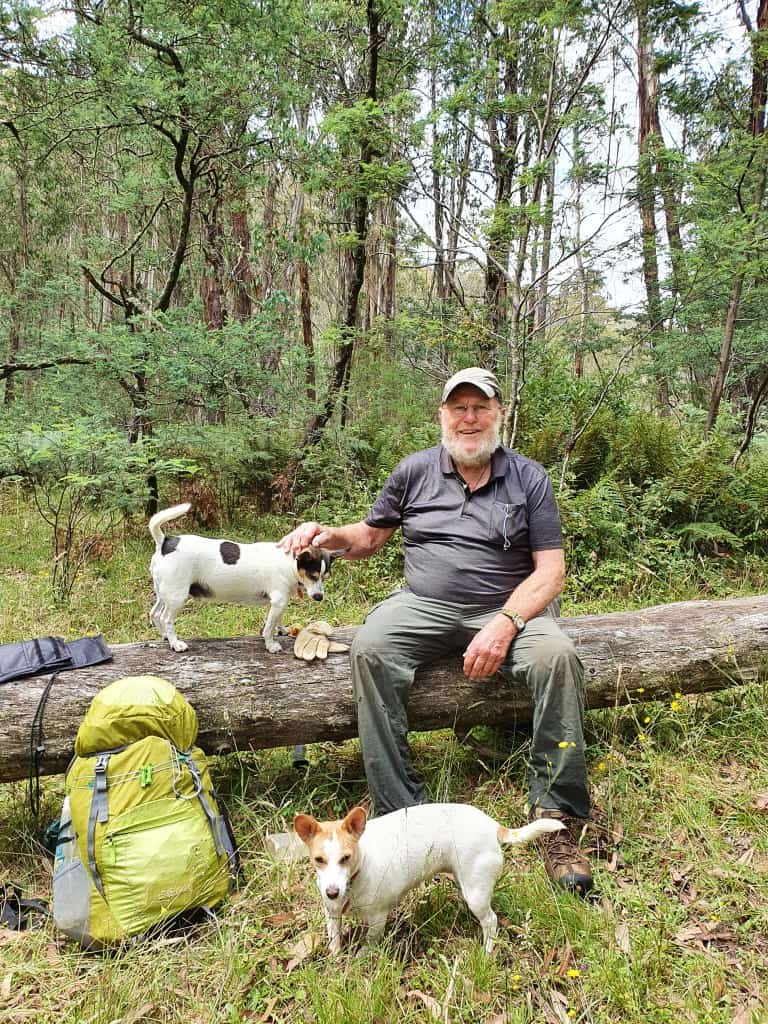
It is after the Mount Darling saddle that your(our) travails begin. There are (at least) four tracks traversing diagonally (southwards) up the ridge beyond. One of them is the Carey Road. It is not the lowest one which slopes away downhill though this might not be apparent for a while due to the thickness of the vegetation. Probably it s the second. Maybe the third. I can’t remember and did not find out this trip. PS: I think it might be better if you essay the third.
This is what the good going was like. Most was too thick for photos. We just had to hack and/or force our way through. Many places you could not.
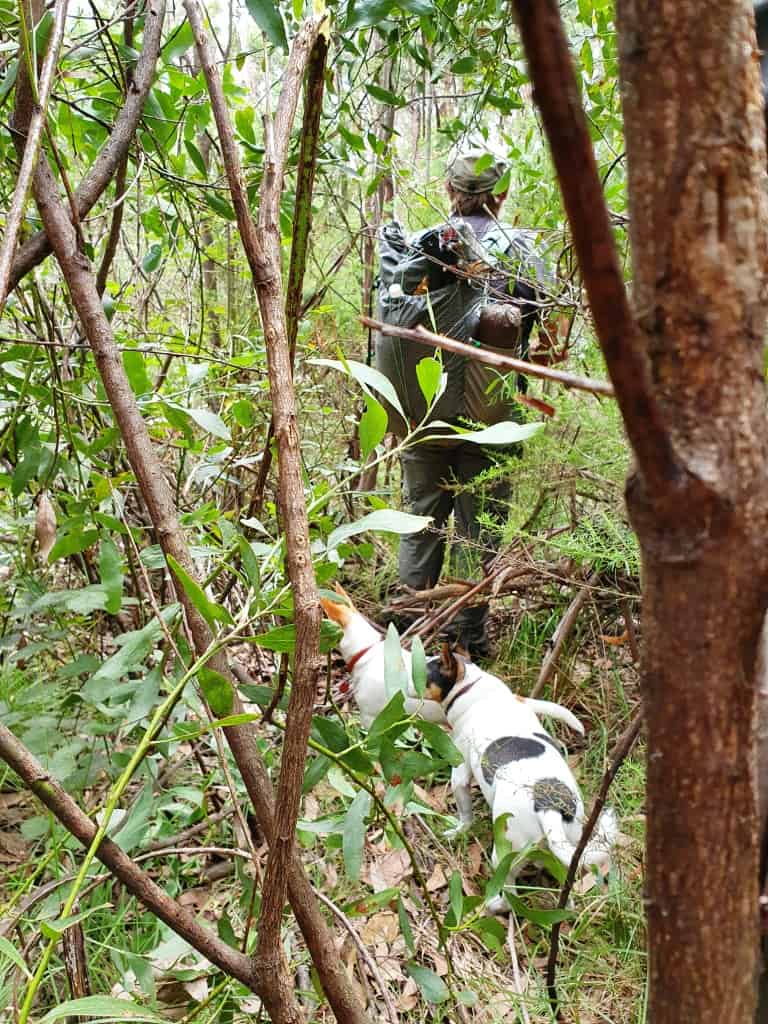
The second one is (now) ‘walkable’ pretty much al the way to the ridge top (around where the loop in the road with the intersection to the hut I mentioned before used to be. I won’t say it is clear but we have traversed most of it at least once and some of it twice and have broken our way through at least. It now needs someone to follow with a machete.
Let me tell you though there was a lot of work just clearing a way through to the saddle. It was also one of those days (periods) when the BOM had taken a holiday so that ‘ideal’ walking conditions of 13-15C turned into something like 21-25C (even though it remained cooler than that 1500 metres below that where we live. The reverse is normally the case, but alpine weather is fickle. It was also very very humid. The hard work also made for very thirsty going, and we had not prepared ourselves with enough water.
With regard to which let me mention that (if there is a damp patch) on this second track you should know that just above it (perhaps thirty yards) on the third track that damp patch is a trickle/small stream which could be developed to provide enough water to save your life (or perhaps if someone cared to clear the track to it and develop it a good (enough) source of water for camping at Mt Darling Saddle. It is probably only 150-200 metres on from the saddle. (BTW: You may need the tip at the end of this post)
You may think (foolishly) that this ought to be what public servants such as Parks Victoria etc ought to be doing, but you would be wrong. They have all been to University and so learned there not to work, as everyone does – which is why the country has been going to wrack and ruin for so long. We probably should abolish the universities now as they have been so degraded from their true purpose as intellectual leaders and places of scholarship for so long they are not worth saving. They have become little more than places of ideological indoctrination, plagiarism and mediocrity. Putting all the poor ‘graduates’ to some real work now would cause some anguish though, wouldn’t it?
‘Graduate’. What a word. You ‘graduate’ from kindergarten these days. I figure today’s graduates have rather less intellectual attainment than my mother and father had at the end of primary school in the 1920s. With only Year 8 education my father was able (at one point in his life) to hold down a job as a proof reader in a major Australian newspaper when those were a lot more literate than they are now (which would not be hard!)
I still have my mother’s primary school maths text book. The level of maths expected of her is not attained today by most high school graduates – and most are allowed to ‘graduate’ from high school without any maths at all. What a travesty that is! Of course they are also allowed to graduate from University without any literacy at all – not what would have been described as literacy in say 1900 anyway. They are now giving teacher graduates crash courses in literacy – this after 17 or so years of schooling. I had had ten years when I finished school and started work at 15! All those (my) ‘education’ billions wasted today.
As we approached the ridge top we were hoping always that the track would ‘open up’ – as Google Earth shows it does. Lying bastards. They have stitched together photos of two completely different years, perhaps even a decade apart and claim it is 2021 satellite imagery! Seriously. Right there.
By then we had less than a litre of water between us. We would have been seriously wretched if we had turned back with a litre of water to last us for nearly three hours’ walking. And we were only a couple of hundred yards from the Mount Creek – not that you could see it.
The brush was so thick we could only barely push through it at a snail’s pace. We were fortunate enough to hit one or two clear(ish) leads on the way. When we finally burst through into a sphagnum bog replete with innumerable blackwater sambar wallows I immediately said, ‘Well, at least we are not going to die of thirst after all’. It was a bit ‘touch and go’. Incidentally it was our 48th wedding anniversary. What a woman! I think we drank our last couple of mouthfulls of water then.
We were close enough to the creek (perhaps twenty yards) to hear it, but none of those thoughtless cervids had pushed a track through at just that point, so we had to break our way again through the last twenty yards where we fell into the creek and immediately consumed 1 1/2 litres of delicious water each before we moved another foot! And we were both just ‘done in’. There was a patch of cushiony grass a few yards further on which did not offer the ideal campsite but it was going to have to do. It was impossible to get the tent pegs to hold but the spot was so sheltered it did not matter, so we bivouacked there.
Mount Creek: I could almost drink another gallon or two right now, couldn’t you?
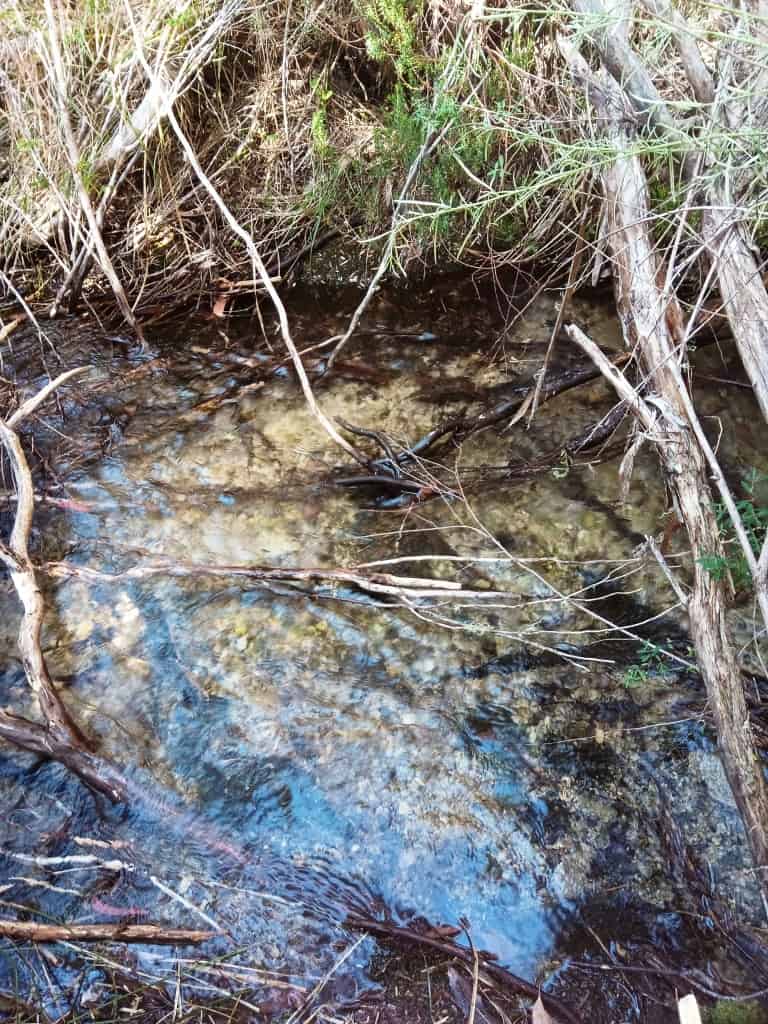
Our camp site on the Mount Creek. It looked better like this in the morning packing up. The dogs were even reluctant to leave.
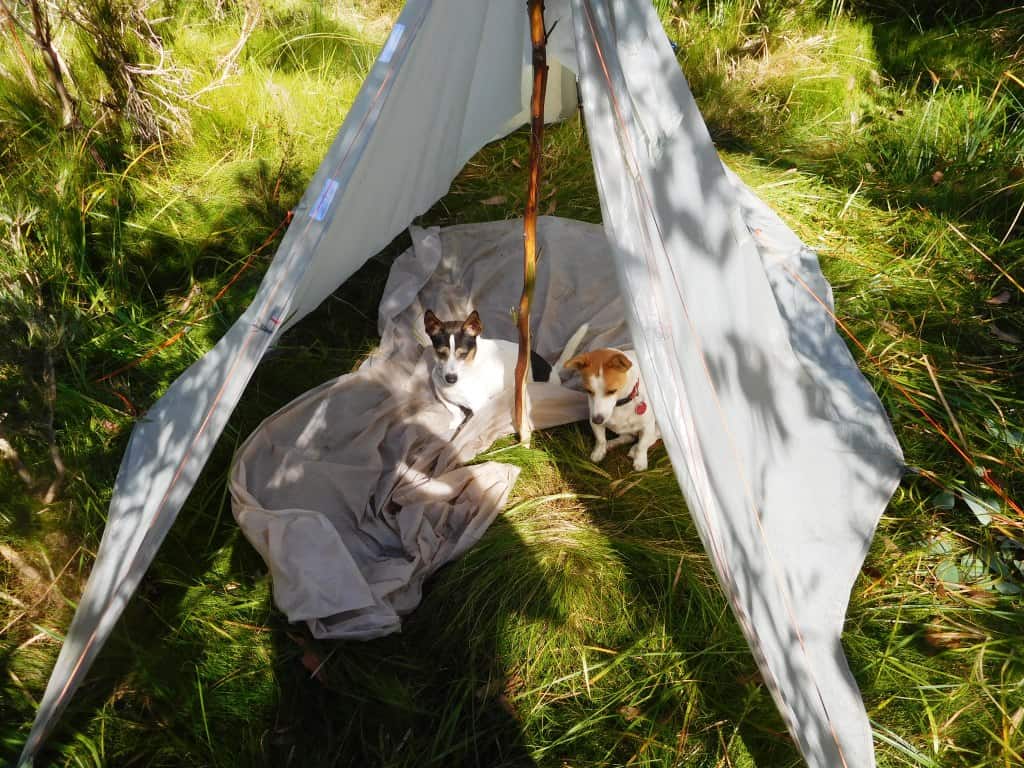
It wasn’t much of a clearing though – as you can see!
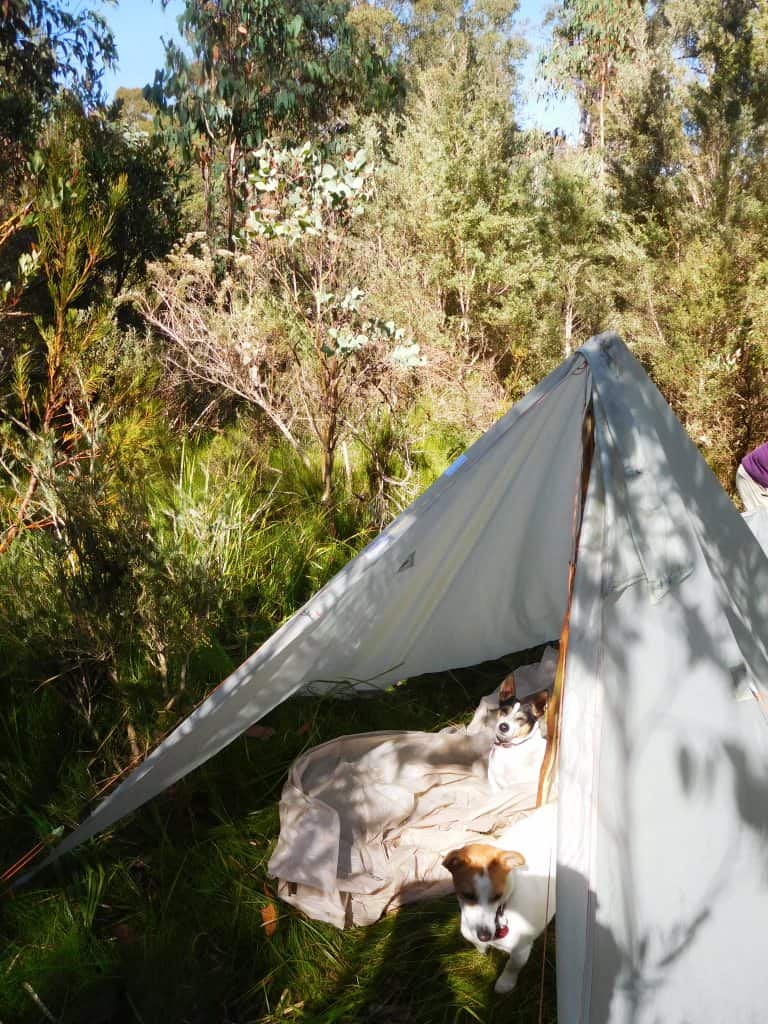
We had intended to go on, but that will be for another time, perhaps after I have cleared a proper track for Della – if she can be persuaded to accompany me anywhere ever again! She is a wonderful woman though. I think I should omit that ‘though’. The pressing problem we had now was that it was hot, we were old and we had been doing (and had still do do) a lot of work. We needed to get back to our previous night’s camp, spend another night there, then walk on out the following day (without dying).
I know this sounds like giving up, but we had to re-find the end of the track, and in that trackless thicket that needed some pretty handy bush navigation. It is very flattish along the Mount Creek and the vegetation is so close and so thick there is no horizon, so spotting exactly where that ‘loop’ must be on the Carey ‘Road’ so that we could find out way back down again was going to be no mean feat. We had also not counted on there being (at least) four roughly parallel tracks slanting up the other side of that ridge towards the loop. God alone knows which one is the ‘real’ Carey Road now.
I judged that the clear ‘leads’ we had found on the way down had led us up the valley enough that if we managed to go straight up we should hit the Carey Road as it looped up the Mount Creek, then we would ‘just’ have to back-clear it. The other alternative was to beat downstream to where the hut is/was (which I would have liked to do – but time & Della) then hack a way up the old track from there. The third alternative would have been to beat our way up the creek to where the Carey Road crosses it then hack back along it until we found our way back to Mt Darling Saddle – again time etc. (I do know there can only be two alternatives – but really, there is always another way!)
Della did not want me to leave her alone there whilst I looked around. I could understand why. Even though we were only 10 yards from the creek the going was so thick I might have had trouble finding her again. You could only see about ten feet in any direction pretty much from when we left the Mt Darling Saddle.
The bush had thickened up dreadfully since I had last been there but I was always expecting it to ‘open up’ as Google Earth (deceptively) shows it doing, or we would eventually come to the fire-cleared ground.
I judged that the ‘easiest’ course was the first one mentioned. Even if we did not hit the road that would mean we were down the ridge from it. Then if we walked up the ridge slightly to the left hand side on it and looking down we ‘should’ see the track we had come up and could then go back down it. It was so thick we might miss it but we could always drop down through the thick bush to the saddle somehow. We made sure to carry enough water to get safely back to our old camp on the return trip, but let me say that we drank it all!
As it happened we did not hit the Carey Road inside the Mount Creek valley. We walked up the ridge and did not find where it crossed the ridge. We did eventually find a track going down in the right direction but realised soon that it was not the one we had come up but that it was also heading for the Saddle, so push on.
After a while we spied a wider track below, dropped down to it and made reasonable progress on it (it was not as thick as the one we had come up the previous day) but it was not the same track either. By then nothing was going to surprise us. When we came to the trickle of water (mentioned before) we reasoned that this must be the same ‘stream’ we had seen a wet patch of on the lower track coming up. All we would have to do was drop down once again and we would be on the track we had come up – and so it proved.
In much shorter time (than the previous day – and in better ‘order’) we were back at the Saddle where we had a delightful lunch stop and a well-deserved rest. It was then relatively easy going getting back as we had cleared the track to the Saddle.That is to say it was an ‘easy’ walk of an hour back to the first saddle (the one with the switchback) then about another forty minutes back to the culvert water source and our first night’s camp. We arrived back around four and just lay around on the grass letting the leeches pour all over us while rehydrating ourselves with the delicious water of the icy culvert.
We would not by the way have died of thirst as we had discovered this damp patch on the way up and I dug it out (‘developed’) it somewhat with a trowel so that there was a (very black) pool of at least four litres of water waiting there for us if we had turned back instead of going on. This would have ‘done’ for a night’s camp at the ‘Saddle’, but I really wanted better water, if possible. You always think that black muddy water will make you sick = or die. Mothers! But it does not (usually). Well not until now at least!
At least you can ‘normally’ eat dirt with impunity. Indeed those folk who survive famine always eat dirt. It usually comprises over half their diet during a famine. Your stomach does extract some nutrient from it and you will survive while others all around you drop like flies. Remember that if you should ever find yourself in a like situation! Hopefully though there will always be something better to eat that just plain dirt. Grass or grasshoppers perhaps. I have sometimes made do on such. Or even McDonalds!
We had a restful night at the culvert camp but wouldn’t you know it, it rained. Quite a lot too. The incompetence of the BOM again. Fortunately our (‘Grey Flyer‘) tent did not leak, but I had not got around to making a proper floor for it so that there were some damp patches. Also it is not quite large enough for two adults and two busy dogs (perhaps if you were more fastidiously organised than is my wont). I may try pitching it lower to see if I can gain the extra width needed (for dogs) that way rather than have to make it bigger (and heavier). Then I will make a floor which keeps things much drier in any case.
I do love those monoliths.
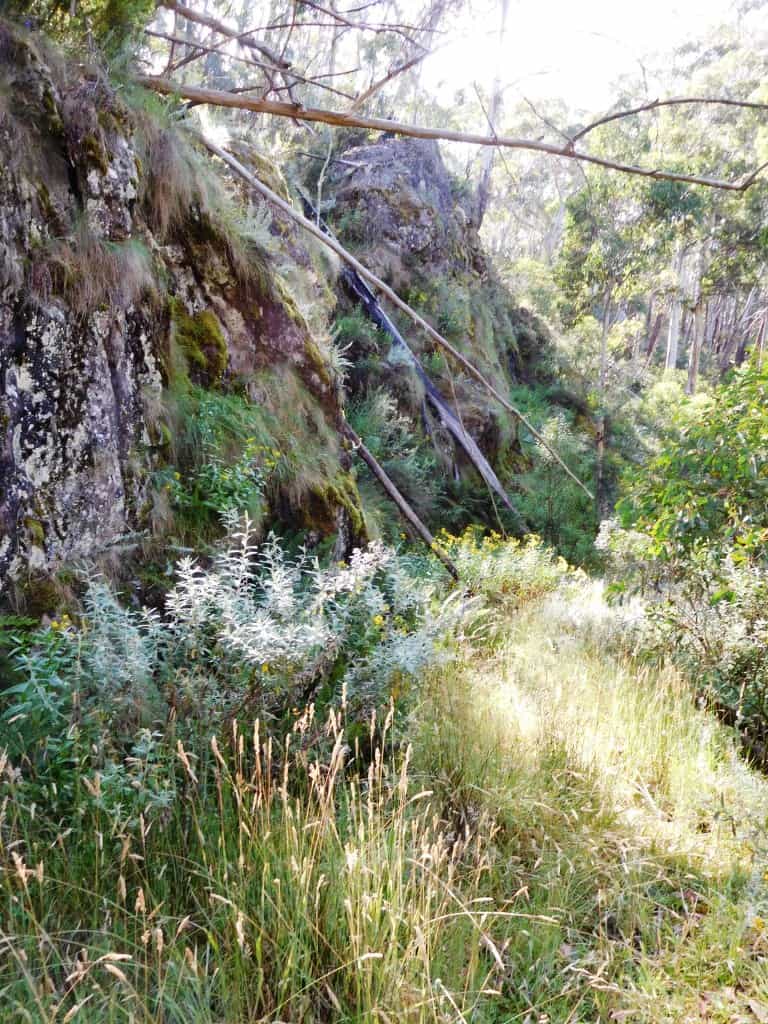
After we arrived back at our car at Dimmicks we could just about think of ‘treating’ ourselves to a nice cup of coffee and a pie (or something) at the Licola store which was fortunately open it not being a Tuesday (when it is not). We did manage the last two pies. Della ‘scored’ a cup of tea and we had an ice cream each. This nearly broke the bank. Supplies cost a bit to get to Licola. You pay for service. Remember that too.
I thought maybe I could take her out for a proper anniversary tea after that fiasco but (Premier) Dan had just announced yet another incompetent lock down while we were gone, so it will have to be postponed. I need to organise something special for her though – maybe like another 48 years of marriage, or maybe a very short time will seem like that anyway? Her most memorable experience of this anniversary was waking in the middle of the night to find that a leech had fallen off the tent roof into her right nostril! Some guys really do know how to spoil the gals!
I had planned an ‘easy’ walk to a camp on the Mount Creek on the first night. Exploration to the potential spring/campsite north of Mt Billabong on the second night – camp there if successful. A foray perhaps to Mt Darling and back to Mount Creek for a camp on the third night, then another comfy walk out from there on the fourth day. All in glorious weather. The reality fell disastrously short, but we remain ‘bowed but unbroken’ – though Della is not looking forward to further wilderness ‘adventures’ in the near future.
We would be having a relaxing canoe trip on the Wonnangatta River (Eaglevale to Black Snake Creek) starting perhaps on Thursday, but this lock down may stymie early future plans. I have work to do on the canoes first anyway. Meanwhile there is always plenty of work to do on the farm. Thank goodness. I can’t imagine how tiresome life in suburbia must be! What a mess of pottage the ad-men have sold the multitude!
Tip: I have learned this about water filters. When your need is greatest they do not filter water! This is a serious problem! My late uncle Ken Jones used always to wear a felt hat (as did his father George – and so on no doubt into the mists of time). This was a certainly sound practice and I may have Della making me some to my own design (she is a master/mistress feltmaker).
He used always to place his hat upside down into a muddy puddle using it to filter the worst of the muck then drink from the inside of the hat. At least you get a drink. A water filter blocks almost immediately if the water is at all muddy – so if it is really only good for filtering tap water, what good is it really? You need to make use of some sort of garment like this as my uncle/grandfather used to do. Perhaps collecting the water then pouring it though the garment filter a number of times until it is suitable for the water filter (or just for drinking)! Mind you I have drunk black water many times and I am not dead (yet)!
The advantages of bush sticks as tent poles: 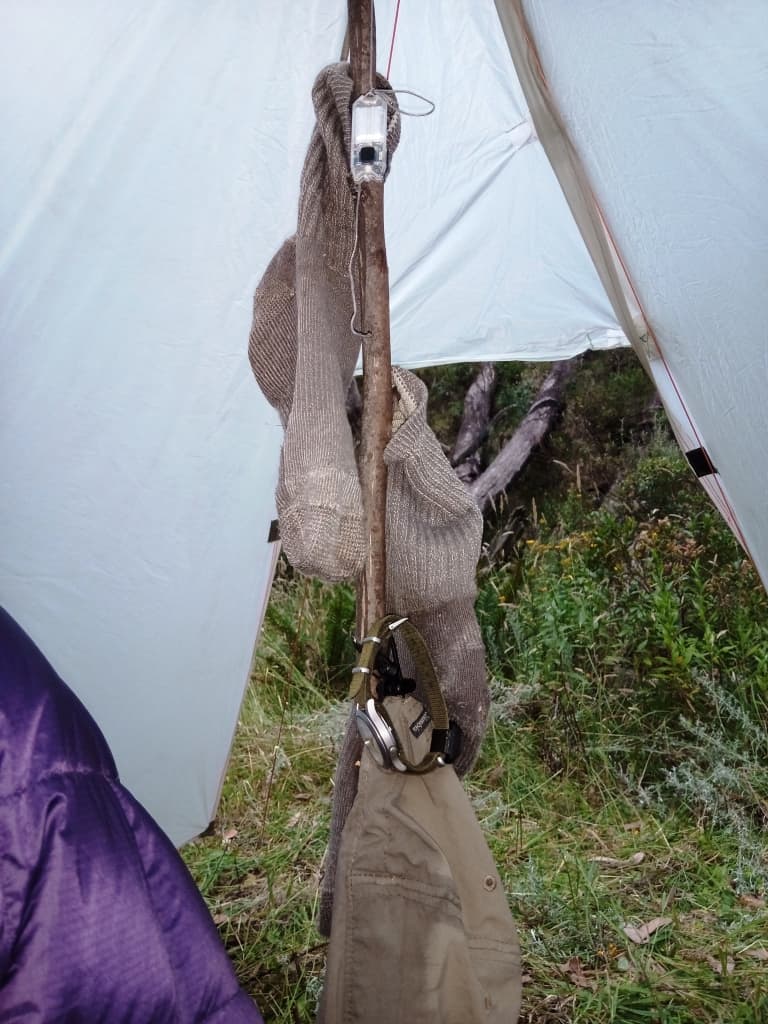
PS: A couple of young backpack hunters armed with Fiskars Machetes would have the track cleared all the way to Mt Darling in a few short days (and maybe create a few other links besides eg down to the Mt Darling Creek-Wonnangatta confluence).
They might even find and restore the hut, and create a camp at the potential spring at the Billabong. What a backpack hunting paradise they would/will have. Frankly if I was 25 again (or even 60 again) I would have the track cleared all the way to Mt Darling in three days good enough to ride a Mountain Bike and I would be in to Mount Creek in half an hour or so!. There is so little big timber down it would be easy.
Of course you would not park your vehicle at the Dimmicks’ entrance. There is a side track half a kilometre further back where it would attract no attention. Someone cleared all the big timber (presumably for this purpose) at least as far as the Mt Darling Saddle since I was there in 2014.
This used to be a good hard wide road semi trailers could drive on. Half a day’s work with a grader and it would be again but that will never happen! Good luck with that mates. I wish I was not well over seventy sometimes, but it as been a good life replete with many adventures – with perhaps just a few more still to come! Cheers, Steve.
PS: Perhaps a 2WD electric assisted mountain bike might be just what I need? I would like to have a another go. We shall see.
See Also
Nuts to Leave No Trace
Upper Yarra Track Shelter House
Snowy Bluff- Mt Darling Wilderness

Hi Steve,
Thanks for the many and varied posts, If people interested in get outdoors and have a open mind I sure most of them could pick up some valuable tips if they take the time to read them. Insted of a electric powered mountain bike this might be useful https://motoped.com/survival/?utm_source=dudeiwantthat.com&utm_medium=referral Not electric but serious great range with the extra fule tanks
Thanks Steve, (for the praise) I have seen that one actually. I already own a dual range postie bike which is probably all I need. The electric bike would be lighter and quieter and can come in 2WD. I will do a post about a DIY version soon. Cheer, Steve.
What a life you have experienced
I agree wholeheartedly with your comments on university and education in general
It’s pathetic at best and sadly these Inept morons are the who make the rules for us uneducated plebs so follow
I say fuck em
Open the place up to everyone willing
Because these tree hugging Soyboys aren’t going to do shit
Love your page mate
I’ve followed you for a few years now but have since pissed off all social media because of constant bans by the political correctness brigade and gone back to basics
Living as self sufficient and I can on my rural property with my family
I love reading about your thoughts and a life full of experiences most of which you can’t learn from a Fuckin book
Thanks for sharing brother
Dan
Thank you for your kind thoughts Dan. Hope you enjoy my latest post which sounds like it might match your philosophy fairly exactly. Best wishes to you and your family, Steve.